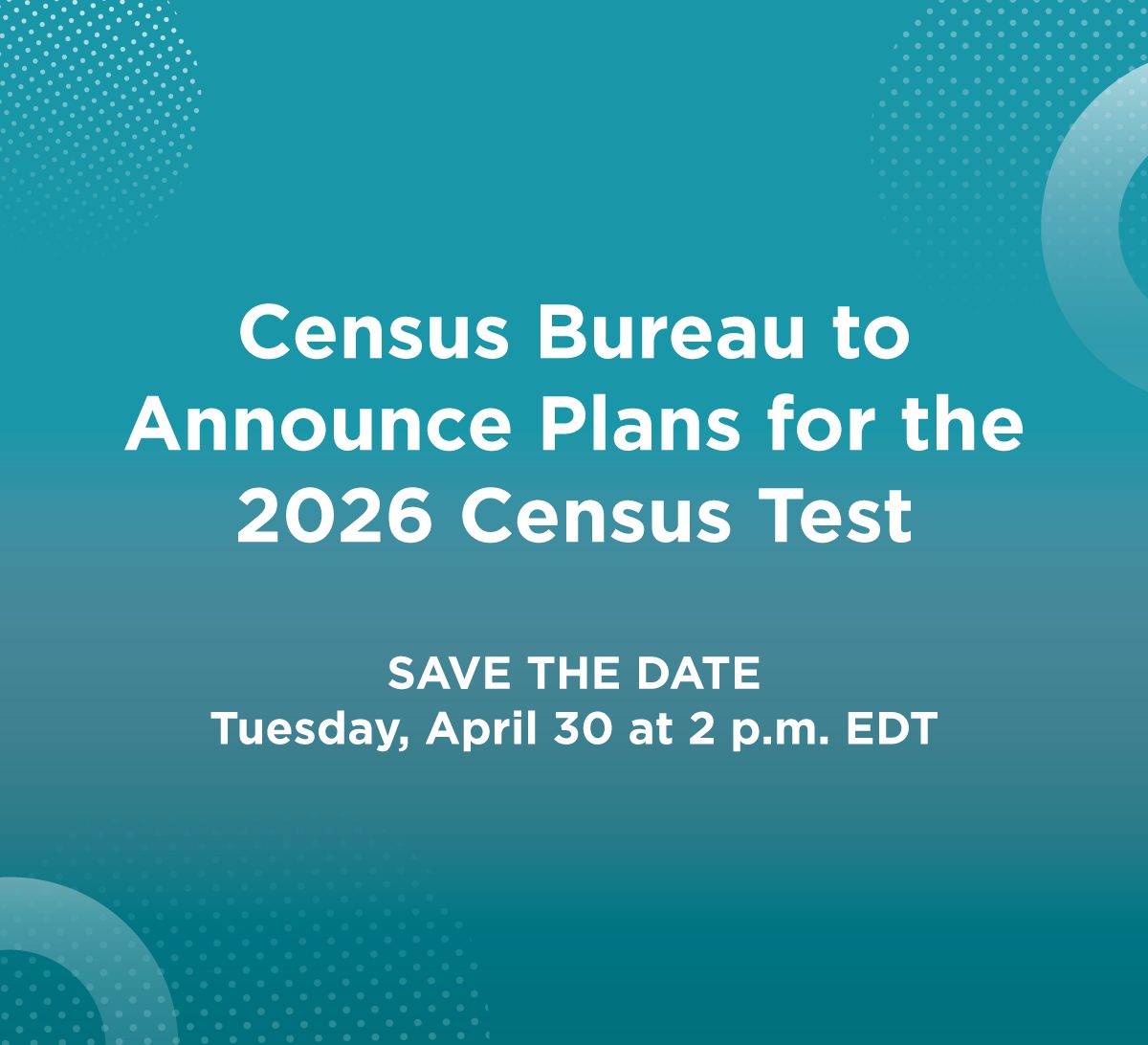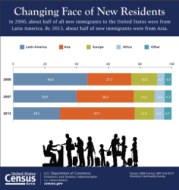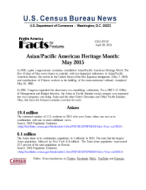Asian/Pacific American Heritage Month: May 2015
In 1978, a joint congressional resolution established Asian/Pacific American Heritage Week. The first 10 days of May were chosen to coincide with two important milestones in Asian/Pacific American history: the arrival in the United States of the first Japanese immigrants (May 7, 1843) and contributions of Chinese workers to the building of the transcontinental railroad, completed May 10, 1869.
In 1992, Congress expanded the observance to a monthlong celebration. Per a 1997 U.S. Office of Management and Budget directive, the Asian or Pacific Islander racial category was separated into two categories: one being Asian and the other Native Hawaiian and Other Pacific Islander. Thus, this Facts for Features contains a section for each.
Graphic [JPG]
Asians
19.4 million
The estimated number of U.S. residents in 2013 who were Asian, either one race or in combination with one or more additional races.
Source: 2013 Population Estimates <//factfinder.census.gov/bkmk/table/1.0/en/PEP/2013/PEPSR5H?slice=Year~est72013>
6.1 million
The Asian alone or in combination population in California in 2013. The state had the largest Asian population, followed by New York (1.8 million). The Asian alone population represented 37.7 percent of the total population in Hawaii.
Source: 2013 Population Estimates <//factfinder.census.gov/bkmk/table/1.0/en/PEP/2013/PEPSR5H?slice=Year~est72013>
4.3 million
Number of Asians of Chinese, except Taiwanese, descent in the U.S. in 2013. The Chinese (except Taiwanese) population was the largest Asian group, followed by Filipinos (3.6 million), Asian Indians (3.5 million), Vietnamese (1.9 million), Koreans (1.8 million) and Japanese (1.4 million). These estimates represent the number of people who reported a specific detailed Asian group alone, as well as people who reported that detailed Asian group in combination with one or more other detailed Asian groups or another race(s).
Source: U.S. Census Bureau, 2013 American Community Survey, Table B02018 <//factfinder.census.gov/bkmk/table/1.0/en/ACS/13_1YR/B02018>
Income, Poverty and Health Insurance
$72,472
Median income of households headed by the Asian alone population in 2013. Median household income differed greatly by Asian group. For Asian Indians, for example, the median income in 2013 was $100,547; for Bangladeshi, it was $51,331. (These figures represent the Asian alone population.)
Source: U.S. Census Bureau, 2013 American Community Survey, Table S0201,
<//factfinder.census.gov/bkmk/table/1.0/en/ACS/13_1YR/S0201//popgroup~012>
<//factfinder.census.gov/bkmk/table/1.0/en/ACS/13_1YR/S0201//popgroup~013|014>
12.7%
The poverty rate for the Asian alone population in 2013.
Source: U.S. Census Bureau, 2013 American Community Survey, Table S0201
<//factfinder.census.gov/bkmk/table/1.0/en/ACS/13_1YR/S0201//popgroup~012>
14.6%
Percentage of Asian alone population without health insurance coverage in 2013.
Source: U.S. Census Bureau, 2013 American Community Survey, Table S0201
<//factfinder.census.gov/bkmk/table/1.0/en/ACS/13_1YR/S0201//popgroup~012>
Education
51.3%
The percentage of the Asian alone population 25 and older who had a bachelor’s degree or higher level of education. This compared with 29.6 percent for all Americans 25 and older.
Source: U.S. Census Bureau, 2013 American Community Survey, Table S0201,
<//factfinder.census.gov/bkmk/table/1.0/en/ACS/13_1YR/S0201//popgroup~012> and
<//factfinder.census.gov/bkmk/table/1.0/en/ACS/13_1YR/S0201>
86.2%
The percentage of the 25-and-older Asian alone population who had at least a high school diploma. This compares with 86.6 percent of the total population.
Source: U.S. Census Bureau, 2013 American Community Survey, Table S0201,
<//factfinder.census.gov/bkmk/table/1.0/en/ACS/13_1YR/S0201//popgroup~012> and
<//factfinder.census.gov/bkmk/table/1.0/en/ACS/13_1YR/S0201>
21.6%
The percentage of 25-and-older Asian alone population who had a graduate or professional degree. This compared with 11.2 percent for all Americans 25 and older.
Source: U.S. Census Bureau, 2013 American Community Survey, Table S0201,
<//factfinder.census.gov/bkmk/table/1.0/en/ACS/13_1YR/S0201>
Voting
547,000
The additional number of the Asian alone population who voted in the 2012 presidential election than in the 2008 election. All in all, 47.3 percent of Asians turned out to vote in 2012. A total of 3.9 million Asians voted in 2012.
Source: U.S. Census Bureau, The Diversifying Electorate — Voting Rates by Race and Hispanic Origin in 2012 (and Other Recent Elections) Table 2 and Figure 1 <//www.census.gov/prod/2013pubs/p20-568.pdf>
Serving Our Nation
276,867
The number of the Asian alone population who were military veterans in 2013. About two in five Asian veterans was 65 and older.
Source: U.S. Census Bureau, 2013 American Community Survey, Table B21001D,
<//factfinder.census.gov/bkmk/table/1.0/en/ACS/13_1YR/B21001D>
Jobs
50.0%
The proportion of civilian employed Asian alone population 16 and older who worked in management, business, science and arts occupations in 2013. Additionally, 17.0 percent worked in service occupations, 20.4 percent in sales and office occupations, 9.5 percent in production, transportation and material moving occupations and 3.0 percent in natural resources, construction and maintenance occupations.
Source: U.S. Census Bureau, 2013 American Community Survey, Table S0201,
<//factfinder.census.gov/bkmk/table/1.0/en/ACS/13_1YR/S0201//popgroup~012>
Internet Use
89.9%
Percentage of Asian alone population in 2013 living in a household with Internet use — the highest rate among race and ethnic groups.
Source: U.S. Census Bureau, Computer and Internet Use in the United States: 2013 Table 2,
<//www.census.gov/content/dam/Census/library/publications/2014/acs/acs-28.pdf>
Age Distribution
36.3
Median age of the Asian alone population in 2013. The corresponding figure was 37.5 for the population as a whole.
Source: U.S. Census Bureau, 2013 American Community Survey, Tables S0201,
<//factfinder.census.gov/bkmk/table/1.0/en/ACS/13_1YR/S0201//popgroup~012> and
<//factfinder.census.gov/bkmk/table/1.0/en/ACS/13_1YR/S0201>
21.1%
Percentage of the Asian alone population that was under age 18 in 2013, while 10.7 percent was 65 or older.
Source: U.S. Census Bureau, 2013 American Community Survey, Table S0201,
<//factfinder.census.gov/bkmk/table/1.0/en/ACS/13_1YR/S0201//popgroup~012>
Native Hawaiians and Other Pacific Islanders
1.4 million
The estimated number of U.S. residents in 2013 who were Native Hawaiian or Other Pacific Islander, either alone or in combination with one or more additional races.
Source: 2013 Population Estimates
<//factfinder.census.gov/bkmk/table/1.0/en/PEP/2013/PEPSR5H?slice=Year~est72013>
366,425
The estimated number of Hawaii residents in 2013 who were Native Hawaiian or Other Pacific Islander, either alone or in combination with one or more additional races — the most of any state. California followed with 340,309. Hawaii also had the largest portion of its population being Native Hawaiian or Other Pacific Islander at 26 percent.
Source: 2013 Population Estimates <//factfinder.census.gov/bkmk/table/1.0/en/PEP/2013/PEPSR5H>
560,488
Number of Native Hawaiians in the U.S. in 2013. The Native Hawaiian population was the largest detailed Native Hawaiian and Other Pacific Islander (NHPI) group, followed by Samoan (175,589) and Guamanian or Chamorro (120,706). These estimates represent the number of people who reported a specific detailed NHPI group alone, as well as people who reported that detailed NHPI group in combination with one or more other detailed NHPI groups or another race(s).
Source: U.S. Census Bureau, 2013 American Community Survey, Table B02019,
<//factfinder.census.gov/bkmk/table/1.0/en/ACS/13_1YR/B02019>
Income, Poverty and Health Insurance
$50,591
The median income of households headed by Native Hawaiians and Other Pacific Islanders alone in 2013.
Source: U.S. Census Bureau, 2013 American Community Survey, Table S0201,
<//factfinder.census.gov/bkmk/table/1.0/en/ACS/13_1YR/S0201//popgroup~050>
20.1%
The poverty rate in 2013 of the Native Hawaiian and Other Pacific Islanders alone population.
Source: U.S. Census Bureau, 2013 American Community Survey, Table S0201,
<//factfinder.census.gov/bkmk/table/1.0/en/ACS/13_1YR/S0201//popgroup~050>
17.9%
The percentage without health insurance in 2013 for Native Hawaiians and Other Pacific Islanders alone.
Source: U.S. Census Bureau, 2013 American Community Survey, Table S0201,
<//factfinder.census.gov/bkmk/table/1.0/en/ACS/13_1YR/S0201//popgroup~050>
Education
16.0%
The percentage of Native Hawaiians and Other Pacific Islanders alone age 25-and-older who had a bachelor’s degree or higher in 2013. This compared with 29.6 percent for the total population.
Source: U.S. Census Bureau, 2013 American Community Survey, Tables S0201,
<//factfinder.census.gov/bkmk/table/1.0/en/ACS/13_1YR/S0201//popgroup~050> and
<//factfinder.census.gov/bkmk/table/1.0/en/ACS/13_1YR/S0201>
86.4%
The percentage of Native Hawaiians and Other Pacific Islanders alone age 25 and older who had at least a high school diploma in 2013. This percentage is not statistically different from the 86.6 percent of the total population who have at least a high school diploma or the 86.2 percent of Asians with at least a high school diploma.
Source: U.S. Census Bureau, 2013 American Community Survey Tables S0201,
<//factfinder.census.gov/bkmk/table/1.0/en/ACS/13_1YR/S0201//popgroup~050> and
<//factfinder.census.gov/bkmk/table/1.0/en/ACS/13_1YR/S0201>
4.2%
The percentage of Native Hawaiians and Other Pacific Islanders alone age 25 and older who had obtained a graduate or professional degree in 2013. This compared with 11.2 percent for the total population this age.
Source: U.S. Census Bureau, 2013 American Community Survey, Tables S0201,
<//factfinder.census.gov/bkmk/table/1.0/en/ACS/13_1YR/S0201//popgroup~050> and
<//factfinder.census.gov/bkmk/table/1.0/en/ACS/13_1YR/S0201>
Serving Our Nation
30,021
The number of Native Hawaiian and Other Pacific Islanders alone who were military veterans. About one in five Native Hawaiian and Other Pacific Islanders veterans was 65 and older.
Source: U.S. Census Bureau, 2013 American Community Survey Table B21001E,
<//factfinder.census.gov/bkmk/table/1.0/en/ACS/13_1YR/B21001E>
Jobs
25.2%
The proportion of civilian employed Native Hawaiians and Other Pacific Islanders alone 16 and older who worked in management, business, science and arts occupations, in 2013. Additionally, 26.1 percent worked in service occupations, while 25.2 percent worked in sales and office occupations; 14.9 percent in production, transportation and material moving occupations; and 8.6 percent in natural resources, construction and maintenance occupation.The proportions in management, business, science and arts occupations, service occupations, and sales and office occupations are not statistically different from one another.
Source: U.S. Census Bureau, 2013 American Community Survey, Table S0201,
<//factfinder.census.gov/bkmk/table/1.0/en/ACS/13_1YR/S0201//popgroup~050>
Age Distribution
30.5
The median age of the Native Hawaiian and Other Pacific Islander alone population in 2013. The median age was 37.5 for the population as a whole.
Source: U.S. Census Bureau, 2013 American Community Survey, Tables S0201,
<//factfinder.census.gov/bkmk/table/1.0/en/ACS/13_1YR/S0201//popgroup~050> and
<//factfinder.census.gov/bkmk/table/1.0/en/ACS/13_1YR/S0201>
27.9%
Percentage of the Native Hawaiian and Other Pacific Islander alone population that was under age 18 in 2013, while 7.1 percent was 65 or older.
Source: U.S. Census Bureau, 2013 American Community Survey, Table S0201,
<//factfinder.census.gov/bkmk/table/1.0/en/ACS/13_1YR/S0201//popgroup~050>
The following is a list of observances typically covered by the Census Bureau’s Facts for Features series:
| Black (African American) History Month (February) Super Bowl Valentine's Day (Feb. 14) Women's History Month (March) Irish-American Heritage Month (March)/ St. Patrick's Day (March 17) Earth Day (April 22) Asian/Pacific American Heritage Month (May) Older Americans Month (May) Mother's Day Hurricane Season Begins (June 1) Father's Day |
The Fourth of July (July 4) Anniversary of Americans With Disabilities Act (July 26) Back to School (August) Labor Day Grandparents Day Hispanic Heritage Month (Sept. 15-Oct. 15) Unmarried and Single Americans Week Halloween (Oct. 31) American Indian/Alaska Native Heritage Month (November) Veterans Day (Nov. 11) Thanksgiving Day The Holiday Season (December) |
Editor’s note: The preceding data were collected from a variety of sources and may be subject to sampling variability and other sources of error. Facts for Features are customarily released about two months before an observance in order to accommodate magazine production timelines. Questions or comments should be directed to the Census Bureau’s Public Information Office: telephone: 301-763-3030; or e-mail: pio@census.gov.








